|
Chevrolet Corvette
Debut: 2004
Maker: General Motors
Predecessor: Chevrolet Corvette C5
|
|
 50
years and 5 generations passed, Corvette is still the definitive
American
sports car, the dream car of every American schoolboy. The emergence of
Viper and Ford GT have nothing to do with its legendary status. It
remains
to be American’s only mass production sports car (while Viper and Ford
GT are not), keeps selling at a rate of 30,000 units a year, without
any
sign of decline. This evergreen status is only matched by another car
across
the Atlantic: Porsche 911. 50
years and 5 generations passed, Corvette is still the definitive
American
sports car, the dream car of every American schoolboy. The emergence of
Viper and Ford GT have nothing to do with its legendary status. It
remains
to be American’s only mass production sports car (while Viper and Ford
GT are not), keeps selling at a rate of 30,000 units a year, without
any
sign of decline. This evergreen status is only matched by another car
across
the Atlantic: Porsche 911.
When
the fifth
generation
Corvette (or C5) ended its life in 2004, it was still very competitive.
If you remember, C5 was a clean sheet design and a major advancement
over
C4. Its advanced chassis was 4.5 times stiffer than the car it replaced
and simultaneously being lightweight (just 1465kg) and well balanced
(51:49
front to rear). Its LS1 V8 was all-alloy and produced 350 horsepower,
remarkable
for a push-rod engine. The 405hp Z06 even won the admiration from
European
car journalists, a thing haven’t happened since the days of Sting Ray.
So what can C6 improve on it?
C6 - the
sixth
generation
Corvette
Compare with
C5,
the new
C6 Corvette is more evolutionary than revolutionary. Because the
fundamental
is so right, C6 does not need any major modifications. Improvement
concentrates
on making it a little smaller and nimbler to handle, a little more
powerful
and a little easier to live with.
 Its
styling continues the evolution from the C4 and C5, preserving the same
sexy profile. The body shape becomes a little more muscular and
aggressive
in the attempt to resemble Sting Ray, but the biggest change is at the
nose, where the pop-up headlamps are replaced with fixed units. Its
styling continues the evolution from the C4 and C5, preserving the same
sexy profile. The body shape becomes a little more muscular and
aggressive
in the attempt to resemble Sting Ray, but the biggest change is at the
nose, where the pop-up headlamps are replaced with fixed units.
In
order to match
Porsche
in handling, GM deliberately reduced the size of the C6. Compare with
C5,
it is 2.5cm narrower and 13cm shorter, though wheelbase grows by 3cm,
reducing
front and rear overhangs further. The body is still made of
glass-fiber-reinforced
plastics (like all its predecessors). Its drag coefficient is reduced
slightly
from 0.29 to 0.28, while aerodynamic lift is also reduced.
The
C6 chassis
follows the
technology used by C5. This is a backbone-type chassis with hydroformed
steel rails and a floorboard made of balsa wood and fiberglass sandwich
to obtain high rigidity and lightweight. The all-alloy engine is
mounted
up front, the transaxle 6-speed gearbox is mounted at the rear, with a
strong aluminum torque tube linking between them. Front and rear weight
distribution remains unchanged at 51:49. Besides, the car successfully
kept its kerb weight at 1470kg.
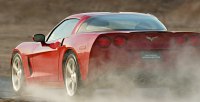 There
is no big change in the suspensions either, although none of the
components
are carried over. The C6 still rides on cast aluminum unequal-length
A-arms
with leaf springs at each corner. However, suspension travel is
increased
to improve ride comfort. Besides, bigger wheels, wider tires and bigger
brakes are employed. There
is no big change in the suspensions either, although none of the
components
are carried over. The C6 still rides on cast aluminum unequal-length
A-arms
with leaf springs at each corner. However, suspension travel is
increased
to improve ride comfort. Besides, bigger wheels, wider tires and bigger
brakes are employed.
You
can opt for 3
different
suspension settings - the standard, the sportier Z51 package and the
Magnetic
Ride Control (See my Cadillac XLR report for explanation to MRC). The
Z51
package is the default choice for demanding drivers. It also includes a
close ratio gearbox and stronger brakes.
More powerful
LS2 engine
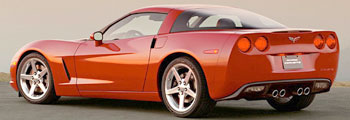 Throughout
the years Corvette persisted in using push-rod V8s, even though
technology
fans like me doubted the future of such engines. Overhead-valve V8s may
never match the efficiency of dohc V8s, but they are relatively simple,
cheap and lightweight. In the C5, GM successfully made its LS1 V8 so
compact
and lightweight, while raised its revvabiilty and efficiency
significantly. Throughout
the years Corvette persisted in using push-rod V8s, even though
technology
fans like me doubted the future of such engines. Overhead-valve V8s may
never match the efficiency of dohc V8s, but they are relatively simple,
cheap and lightweight. In the C5, GM successfully made its LS1 V8 so
compact
and lightweight, while raised its revvabiilty and efficiency
significantly.
Back
in 1984, the
C4's 5.7-litre
V8 pumped out only 230 horsepower. 13 years later, the same
displacement
produced 345 horsepower in the C5. Z06 even raised the horsepower count
to 405, all achieved without any increase of displacement. For the same
period, Porsche 911 Carrera had its power raised from 231hp to 300hp
only,
even though it switched from air cool to water cool, 2 valves to 4
valves
per cylinder along with an additional 200cc. One can see how far GM's
push-rod
V8s had progressed.
For C6, GM
once
again raised
the efficiency of it push-rod V8, from 61 to 67 hp / litre, taking the
horsepower count to 400. At the same time, its weight is trimmed by
7kg.
Combined fuel consumption is improved to 22.6 mpg, remarkable for the
performance
it delivers.
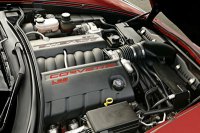 The
new LS2 V8 is based on GM’s Gen IV small-block family. It is also a
development
from the previous LS1. Bored out to 6.0 litres, accompany with higher
compression
ratio (up from 10.1:1 to 10.9:1), enhanced intake and exhaust breathing
and revised cam timing and lift, its redline is stretched from 6000rpm
to 6500rpm, taking max output to 400 horsepower @ 6000rpm and max
torque
to 400 lbft @ 4400rpm. The
new LS2 V8 is based on GM’s Gen IV small-block family. It is also a
development
from the previous LS1. Bored out to 6.0 litres, accompany with higher
compression
ratio (up from 10.1:1 to 10.9:1), enhanced intake and exhaust breathing
and revised cam timing and lift, its redline is stretched from 6000rpm
to 6500rpm, taking max output to 400 horsepower @ 6000rpm and max
torque
to 400 lbft @ 4400rpm.
Four
hundred
horsepower enables
the Vette to storm from rest to 60 mph in 4.5 seconds and top 186 mph.
It has entered the league of 911 Turbo and Ferrari 360 ! yet this is
just
the standard Corvette costing around US$50,000 ! in fact, the Vette’s
direct
competitor should be Porsche Boxster S and Chrysler Crossfire SRT-6,
both
cannot match Corvette in performance.
Easier to
live
with
The C5’s
biggest
critic was
its lack of refinement. Like traditional American muscle cars, its
build
quality was rather poor, cockpit looked cheap, ride too stiff, controls
too truck-like, had too much road noise... in the past, GM saw these
glitches
as part of its "American character" - who cares? now in the attempt to
be a world-class player, C6 starts tackling these problems.
The
fiberglass
body is now
made with better quality. The styling of interior is bit dull but still
an improvement over the C5. It employs much better quality plastics,
though
no match with European products. What it shines is the amount of
passenger
room. The C5 was already generous in this area, but the C6 adds more
headroom
by raising the roof and more foot room by pushing the V8 a couple of
inches
forward (thanks to the lighter engine, this didn’t deteriorate weight
distribution).
Sound insulation is also improved.
The 6-speed
Tremec gearbox
received a shorter gear lever and its throw travel is reduced to make
gearshift
quicker and cleaner. The new clutch requires a lot less pedal effort.
The
aforementioned longer travel suspensions enable smoother ride.
On the Road
Most motor
journalists praised
the C6’s new cabin - frankly speaking, this mainly reflected how poor
the
old car was. The Vette is a pure sports car. Its driver sits low in the
cabin, watching through the steeply raked windscreen towards the long
bonnet
and the pronounced flanks. This view is exciting. Push the starter
button
and the mega V8 excites you even more. As rev rise, deep rumble turns
into
musical vocal. You can’t help thinking the America is the promised land
for car enthusiasts...
 On
open and smooth motorway, few cars can beat the Vette. Its large
capacity
V8 produces tons of torque. You don’t need to wind up the engine like
Ferrari
360, just a small press on the throttle pedal will translate into
instant
acceleration, pushing your neck on the headrest. You can’t help
admiring
the Detroit V8... On
open and smooth motorway, few cars can beat the Vette. Its large
capacity
V8 produces tons of torque. You don’t need to wind up the engine like
Ferrari
360, just a small press on the throttle pedal will translate into
instant
acceleration, pushing your neck on the headrest. You can’t help
admiring
the Detroit V8...
But not the
Tremec 6-speed
manual gearbox. Despite of short throw, the gearshift is as stiff and
as
sticky as before. It is a big let down to the otherwise sensational
motorway
performance, because the Vette is so powerful, so stable and so grippy.
It also rides noticeably smoother and quieter than its predecessor,
taking
refinement closer to European standard.
On backroads,
the
Vette is
less good. Despite of the reduced length and width, you can still feel
its size. There is not lack of front-end grip, but with more mass up
front
than the rear, the Vette feels no where as agile as the rear-engined
911
(Car and Driver, Road & Track and Automobile magazine tested the C6
against 911 Carrera / Carrera S, all of them came to the same
conclusion).
Drive it through a series of tight bends, the C6 never display the same
precision and sharpness of 911. Push it into corners, it is more
difficult
to place accurately on the desired line, and easier to slide its tail.
It seems that the big motor up front is ruining the dynamic balance.
51:49
might be pretty good for a front-engined Grand Tourer, but a perfect
sports
car needs to be rear-biased, especially when the driving wheels are at
the rear, isn’t it?
However, the
biggest disappointment
is at the steering wheel - though precise and nicely weighted, the
steering
is totally lifeless, lack of any communication from the front wheels.
Blame
to the Magnasteer power steering. Like many other electrically assisted
power steering systems, Magnasteer eliminates the mechanical feedback
from
the front wheels and leads to an artificial feel. It may be acceptable
to a family hatch, but equipping it in the America’s best sports car is
simply an unforgivable mistake.
That’s why I
cannot recommend
this car yet. Before GM get its steering and gearbox right, the C6 is
not
yet a world-class sports car. C6 has kick started the migration to the
world standard, but it is just the beginning. I hope it can keep moving
in this direction while keeping the best of its American element alive,
then maybe one day we can see C7 giving 911 a real fight...
|
| The
above report was last updated on 16 Jan
2005. All Rights Reserved. |
History of Corvette
|
Chevrolet
Corvette is the longest surviving sports car in the world, even
surpassing
Porsche 911 by a decade. The first Corvette was born in 1953 as a
civilized
roadster, powered by a 150hp inline-6 and ran a 2-speed transmission
only.
Because of the lack of performance, sales were poor and GM once wanted
to terminate it. However, in 1955 a reform by Zora Arkus-Duntoz (who
became
the engineering chief and "Grandfather of Corvette" since then)
introduced
V8 power to the Corvette and saved it. Sales picked up steadily as more
modifications were introduced. In its last years annual sales finally
surpassed
the 10,000 units mark.
Arkus-Duntoz
worked on the
second generation Corvette and introduced it in 1963. Nicknamed "Sting
Ray", the C2 defined the character of all its successor - powerful,
stylish and muscular - and is now considered as the most classical
Corvette
of all. Its 5.3-litre "small-block" V8 was already powerful, but fans
were
more fascinated with its "big block" V8 displacing 7 litres and
producing
up to 430 horsepower (rated as "gross power" then, or about 350hp by
today’s
"net power" expression). C2 established a successful foundation for the
forthcoming generations. It recorded 20,000 to 30,000 unit sales every
year.
C3 arrived in
1968 and served
on until 1982. It established a modern styling that still influence
today’s
Corvette. Growing in size and weight, it continued seeking power from
big
block V8s until 1975, when oil crisis and smog control killed these
monster
engines. Returned to small block V8s and hit by emission regulations,
horsepower
dropped significantly. The Vette no longer shone in performance.
However,
C3 still recorded an all time sales record of 54,000 units in 1979.
After
soldiering
on for 14
years, C3 was finally replaced by C4 in 1984. The fourth generation
Corvette
refined the styling of its predecessor, tamed the muscular lines to
deliver
a sophisticated image. People loved its new look immediately. However,
the C4’s 5.7-litre small block V8 produced just 230hp, giving it little
advantage over Porsche 944 and new Japanese rivals like 300ZX and
Supra,
while chassis was always its weakness. Sales declined gradually back to
the 20,000 units mark. GM tried to negate this trend by introducing
ZR-1
(with a Lotus-designed dohc 32-valve V8) and upgrading the standard V8
to 300hp (LT1) and then 330hp (LT4), but not very successful.
Obviously, at
that point
Corvette needed a complete redesign. The C5 born in 1997 was a clean
sheet
design, although its styling evolved from its predecessor. It adopted
an
advanced chassis construction which was 4.5 times stiffer than C4. The
new LS1 5.7-litre V8 was still a push-rod design, but it improved on
revvability
and efficiency to produce a respectable 345hp. Moreover, it switched to
aluminum block to save 40kg from the front axle, in addition to the
move
of transmission to the rear axle, the chassis balanced so much better
than
any previous Corvettes. The C5 also underwent a diet to reduce kerb
weight.
As GM took engineering seriously this time, Corvette finally matched
its
European rivals in handling while exceeding them in performance and
undercutting
them in price. Sales rose back to the 30,000 units level.
|
| The
above report was last updated on 15 Jan
2005. All Rights Reserved. |
Corvette Z06
|
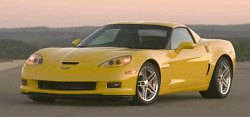 Lamborghini
Gallardo and BMW M6, what do they have in common? the answer is a 500
horsepower, high-tech V10 engine. The 1710 kg M6 takes less than 8
minutes to lap Nurburgring. The 1520 kg Gallardo even did that in 7 min
52 sec. You might think that very fast? look at the American Corvette
Z06: its possesses the same 500 horsepower, but weighs just 1427 kg. It
recorded 7 min 42.99 sec in Nurburgring, making it the third fastest
production car ever recorded there (the first two places are,
unsurprisingly,
Porsche Carrera GT, at 7 min 32 sec, and 996 GT2, at 7 min 42 sec).
Hard to believe. Lamborghini
Gallardo and BMW M6, what do they have in common? the answer is a 500
horsepower, high-tech V10 engine. The 1710 kg M6 takes less than 8
minutes to lap Nurburgring. The 1520 kg Gallardo even did that in 7 min
52 sec. You might think that very fast? look at the American Corvette
Z06: its possesses the same 500 horsepower, but weighs just 1427 kg. It
recorded 7 min 42.99 sec in Nurburgring, making it the third fastest
production car ever recorded there (the first two places are,
unsurprisingly,
Porsche Carrera GT, at 7 min 32 sec, and 996 GT2, at 7 min 42 sec).
Hard to believe.
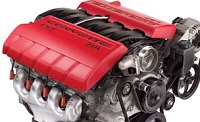 Harder to believe is that kind
of power and performance comes from the latest generation of GM's
40-year-old, push-rod V8. Codenamed LS7, it displaces 7011cc or 427
cubic inches and therefore brings back the memory of the muscle car
era. However, GM said it is still an extension of its "small block" V8,
although its block is enlarged from the standard Corvette's 6.0 LS2
engine. Based on the LS2, it received a larger bore (104.8mm vs
101.6mm) and longer stroke (101.6mm vs 92mm). Despite of the increased
stroke, the LS7 is capable of revving up to 7000rpm, actually higher
than the 6-litre engine. This must thanks to the use of lightweight
moving parts such as titanium connecting rods, pushrods and intake
valves. Breathing is also enhanced by larger valves, higher valve lift,
higher volume intake and exhaust system. Forged pistons and crankshaft
are employed to handle the internal stress of the 11.0:1 compression
engine. Harder to believe is that kind
of power and performance comes from the latest generation of GM's
40-year-old, push-rod V8. Codenamed LS7, it displaces 7011cc or 427
cubic inches and therefore brings back the memory of the muscle car
era. However, GM said it is still an extension of its "small block" V8,
although its block is enlarged from the standard Corvette's 6.0 LS2
engine. Based on the LS2, it received a larger bore (104.8mm vs
101.6mm) and longer stroke (101.6mm vs 92mm). Despite of the increased
stroke, the LS7 is capable of revving up to 7000rpm, actually higher
than the 6-litre engine. This must thanks to the use of lightweight
moving parts such as titanium connecting rods, pushrods and intake
valves. Breathing is also enhanced by larger valves, higher valve lift,
higher volume intake and exhaust system. Forged pistons and crankshaft
are employed to handle the internal stress of the 11.0:1 compression
engine.
The LS7 pumps out 505 horsepower at 6300 rpm and 470 lbft of torque at
4800 rpm, the latter is some 100 lbft more than that of the M6 and
Gallardo ! moreover, at least 400 lbft is available from 2400 to 6400
rpm - this is a true Detroit muscle.
The Z06's power-to-weight ratio is on a par with Ford GT and eclipses
Ferrari F430. GM claims 0-60 mph can be done in 3.7 seconds, partly
thanks to the fact that 1st gear is all it needs to reach that speed.
Car And Driver magazine recorded 7.9 sec at 100 mph, the same as the
figure it recorded for F430. As for top speed, GM itself recorded 198
mph when it took the Z06 to Volkswagen's Ehra-Lessien test track in
Germany. All these facts and figures pointed to a real supercar
performance, yet the Z06 costs just US$66,000 at home and £59,000
in UK ! that's the same price as a basic 911 Carrera or less than half
the price of Ford GT and F430 !
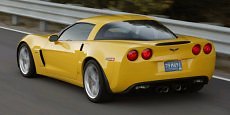 Part of
the reason of its astonishing pace is the C6R racing program -
Chevrolet was developing the race car side by side, benefiting the Z06
program. This is also how Porsche improved its road-going 911. The
racing engineers knew weight is the enemy of sports cars, so they
worked hard to trim weight. They converted the steel chassis frames
into aluminum, the engine cradle and roof frames into magnesium, the
floorboard and front fenders into carbon fiber. The result is 43 kg
reduced from the standard Corvette yet improved chassis torsional
rigidity by 15 percent. Besides, to balance the heavier engine, the
battery is moved to the trunk. It therefore kept the 51:49 front to
rear weight distribution unchanged. Part of
the reason of its astonishing pace is the C6R racing program -
Chevrolet was developing the race car side by side, benefiting the Z06
program. This is also how Porsche improved its road-going 911. The
racing engineers knew weight is the enemy of sports cars, so they
worked hard to trim weight. They converted the steel chassis frames
into aluminum, the engine cradle and roof frames into magnesium, the
floorboard and front fenders into carbon fiber. The result is 43 kg
reduced from the standard Corvette yet improved chassis torsional
rigidity by 15 percent. Besides, to balance the heavier engine, the
battery is moved to the trunk. It therefore kept the 51:49 front to
rear weight distribution unchanged.
The legs are also enhanced. Stiffer suspensions ride on wider tires
(275/35 front and 325/30 rear). Wheels size remain unchanged because
they are already capable to house larger brakes - the front consists of
355mm diameter discs and 6-pot calipers, the rear is 340mm and 4-pot.
As for the body, there are only minor changes, for example, a deeper
lip spoiler, wider wheelarches (the Z06 is 76 mm wider than the
standard Corvette) and, most apparently, an extra nose intake to cool
the mega V8.
On the Road
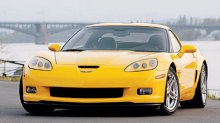 The last
generation Z06 was the only American sports car I admired. The new Z06
lifts the game higher. Think about it, for the price of a base 911
Carrera, you can have a car matching any supercars in speed. That's not
only in straight line, not only in racing circuits, but also any roads,
anywhere. To American, this is like a dream come true. The last
generation Z06 was the only American sports car I admired. The new Z06
lifts the game higher. Think about it, for the price of a base 911
Carrera, you can have a car matching any supercars in speed. That's not
only in straight line, not only in racing circuits, but also any roads,
anywhere. To American, this is like a dream come true.
The mega V8 is wonderful. Like any large capacity American V8, it is
ultra-torquey and tractable at low rev. Deep deep rumble sounds very
Detroit. Passing 3500 rpm, its roar turns loud and raw, increasingly
like a racing car engine. The tremendous acceleration press you on the
deep bucket seat. Having passed 60 mph, shift to second and you will
notice the shifter is as stiff and heavy as the standard Corvette.
Luckily, the mountains of torque means in normal driving you can reduce
the number of gearshifts to minimum.
Turn into the first corner, the Z06 displays sharp turn-in, rock steady
body control and tremendous grip. The supercar-sized rubbers allowed
Car And Driver to record 0.98 g and GM claims 1.04 g is possible. The
steering tendency is close to neutral. Step the throttle in corners, it
could turn into power slide in a progressive way, so the chassis
balance is excellent.
In twisty roads, the Z06 is less good. Despite of its accurate body
control and high cornering limit, it gives its drivers less confidence
than a European sports car, say, 911 Carrera S or F430, or even the
American Ford GT. Part of the reason is the very wide body. Another
reason is the numb steering feel, which is an area it needed to improve
from the standard Corvette but unfortunately it didn't. The chassis
setup may also take a blame - when the Z06 rides over sharp bumps in
mid-corners, its steering kickbacks and it sideways a bit rather than
absorb the bump and keep the chassis tie down. The same would not
happen in a well sorted European sports car.
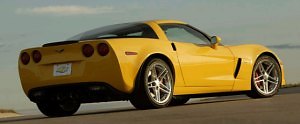 On poor surface, the Z06 rides
harsher than a 911 Carrera S but you can still live with it in daily
basis. Less happy is the annoying noise from various sources - because
it got rid of most sound deadening materials to save weight, there is a
lot of tire noise and gear noise leaked into the cabin. Therefore it is
not a very good companion for long distance journey. Refinement of the
powertrain is unremarkable too. Although you won't expect the
big-capacity push-rod V8 to spin as smooth as an European engine, you
can hardly forgive the annoying rattle from the gear shifter. The same
goes for the low quality cockpit - it is almost unchanged from the
standard Corvette. When you pay for 911 price, you may expect higher
quality. On poor surface, the Z06 rides
harsher than a 911 Carrera S but you can still live with it in daily
basis. Less happy is the annoying noise from various sources - because
it got rid of most sound deadening materials to save weight, there is a
lot of tire noise and gear noise leaked into the cabin. Therefore it is
not a very good companion for long distance journey. Refinement of the
powertrain is unremarkable too. Although you won't expect the
big-capacity push-rod V8 to spin as smooth as an European engine, you
can hardly forgive the annoying rattle from the gear shifter. The same
goes for the low quality cockpit - it is almost unchanged from the
standard Corvette. When you pay for 911 price, you may expect higher
quality.
You can see the two personalities of Corvette Z06: in terms of
performance, it is right in the league of European supercars. In terms
of refinement and quality, it remains an American muscle car. It seems
that most money was put to the engine and weight reduction. Some people
would regard that as unbalanced. Some don't care. The most important is
from now on we have an option to enjoy supercar performance at an
affordable price. Well done GM. |
| The
above report was last updated on 4 Oct 2005. All
Rights Reserved. |
Corvette 6.2
|
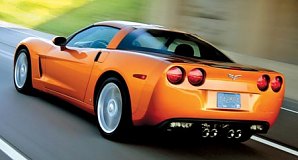 The so-called
2008 Corvette went on sale
in the third quarter of 2007. It is the first major upgrade of the C6
since its birth 3 years ago. Improvements to the car focus on three
areas: engine, steering and gearshift. In the engine compartment, a new
6.2-liter LS3 V8 engine replaces the outgoing 6.0-liter LS2 engine.
With a slightly larger bore, capacity increases to 6162 cc. Although
compression ratio scales back from 10.9 to 10.7:1, it is compensated
with larger valves, higher lift cams, higher flow intake and fuel
injectors. The result is 430 horsepower at 5900 rpm, versus the
previous 400 hp at 6000 rpm. Max torque increases from 400 lb-ft to 424
lb-ft. Besides, an optional variable back-pressure exhaust (like the
one in Z06) can be chosen to release another 6 horsepower and 4 lb-ft. The so-called
2008 Corvette went on sale
in the third quarter of 2007. It is the first major upgrade of the C6
since its birth 3 years ago. Improvements to the car focus on three
areas: engine, steering and gearshift. In the engine compartment, a new
6.2-liter LS3 V8 engine replaces the outgoing 6.0-liter LS2 engine.
With a slightly larger bore, capacity increases to 6162 cc. Although
compression ratio scales back from 10.9 to 10.7:1, it is compensated
with larger valves, higher lift cams, higher flow intake and fuel
injectors. The result is 430 horsepower at 5900 rpm, versus the
previous 400 hp at 6000 rpm. Max torque increases from 400 lb-ft to 424
lb-ft. Besides, an optional variable back-pressure exhaust (like the
one in Z06) can be chosen to release another 6 horsepower and 4 lb-ft.
 Well, the LS3 answers a question nobody asked. Corvette has
never been short of power and performance. In fact, it is not easy to
feel the extra power and performance unless you drive it on race
tracks. Road testers from Car and Driver and Motor Trend measured 4.0
to 4.1 seconds from 0-60 mph on a test car provided by GM, but as usual
we suspect the press car was specially tuned or chosen to deliver
better acceleration than your average Corvette. Without improving
traction, the improvement to 0-60 should be very limited. Anyway, what
you will notice is a raucous exhaust note once the variable exhaust
system opened its high-flow valve. The better sound quality is
definitely more satisfying. Well, the LS3 answers a question nobody asked. Corvette has
never been short of power and performance. In fact, it is not easy to
feel the extra power and performance unless you drive it on race
tracks. Road testers from Car and Driver and Motor Trend measured 4.0
to 4.1 seconds from 0-60 mph on a test car provided by GM, but as usual
we suspect the press car was specially tuned or chosen to deliver
better acceleration than your average Corvette. Without improving
traction, the improvement to 0-60 should be very limited. Anyway, what
you will notice is a raucous exhaust note once the variable exhaust
system opened its high-flow valve. The better sound quality is
definitely more satisfying.
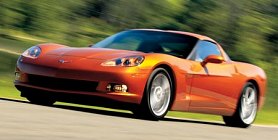 Instead of engine, a more useful improvement is steering
feel. You might remember we criticized the old car for lifeless
steering. It prevented the driver from pushing the Vette right to the
limit on twisty roads. That's why Corvette always shine in race tracks
(where the driver can get familiar with every bend after practice) but
outrun by Porsche 911 in real world. In the 2008 model, GM did two
modifications to the variable assisted rack and pinion steering. First,
the rack is made with tighter tolerance. Rigid roller bearings replace
elastic bushings to hold the rack. Second, the electrical assistance is
recalibrated such that the assistance builds up linearly rather than
abruptly. Now the steering feels lighter and more natural. It still
lacks the tactile feel of Porsche, but it is a big improvement from the
old car and finally it can be driven hard in the twisties with
confidence. Instead of engine, a more useful improvement is steering
feel. You might remember we criticized the old car for lifeless
steering. It prevented the driver from pushing the Vette right to the
limit on twisty roads. That's why Corvette always shine in race tracks
(where the driver can get familiar with every bend after practice) but
outrun by Porsche 911 in real world. In the 2008 model, GM did two
modifications to the variable assisted rack and pinion steering. First,
the rack is made with tighter tolerance. Rigid roller bearings replace
elastic bushings to hold the rack. Second, the electrical assistance is
recalibrated such that the assistance builds up linearly rather than
abruptly. Now the steering feels lighter and more natural. It still
lacks the tactile feel of Porsche, but it is a big improvement from the
old car and finally it can be driven hard in the twisties with
confidence.
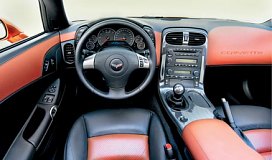 The notorious Tremec 6-speed manual gearbox has also been
improved with lighter gearshift. However, the improvement here is not
as big as the steering. It still feels very American indeed. Those opt
for the paddle-shift 6-speed automatic transmission will find faster
gearshift, claimed to lose only 0.1 seconds for 0-60 mph compare with
the manual. The notorious Tremec 6-speed manual gearbox has also been
improved with lighter gearshift. However, the improvement here is not
as big as the steering. It still feels very American indeed. Those opt
for the paddle-shift 6-speed automatic transmission will find faster
gearshift, claimed to lose only 0.1 seconds for 0-60 mph compare with
the manual.
We have never been a fan of the Corvette's cheap interior. GM this time
offers a premium package including an expensive-looking stitched
leather trim. Unfortunately the package is expensive and it did nothing
to upgrade the cheap plastics and switchgears. The Vette is still a
practical and user-friendly sports car, however. For this price you
can't find another sports car offering such high level of performance,
handling and everyday practicality. It still has a few rough edges, but
without rough edges it won't be a real American sports car. All
strengths and flaws are part of its unique character. And you wouldn't
like it to become just another European car, would you ? |
| The
above report was last updated on 1 Sep 2007. All
Rights Reserved. |
Corvette ZR1
|

|
ZR1 - No other labels could represent
a classier status in the history of Corvette...
|
Why
did GM chose the name “ZR1” for its new flagship Corvette ? There is no
official answer. However, scan through the history of Corvette and the
dozens of labels it ever used, ZR1 is definitely the best choice. GM
used it only once before, in the 1990
Corvette ZR-1
(note that there
was a hyphen then). It was by far the most powerful, the most
sophisticated and the most expensive Corvette then. While a regular
Corvette had a ohv 5.7-liter V8 with 250 horsepower, the ZR-1 was
powered by a brand-new, Lotus built 5.7-liter DOHC 32-valve V8 good for
375 horsepower. It also featured electronic adaptive dampers and a ZF
6-speed gearbox. Price was double of the regular Vette. No other labels
could represent a classier status in the history of Corvette.
Fast forward to 2008, the new ZR1 costs US$120,000 when decently
optioned, compare to US$50,000 of the base Corvette. This time its
engine is built domestically in Detroit, but with an additional
supercharger it produces 638 horsepower instead of the stock 436 hp.
Its claimed performance is equally astonishing – 205 mph top speed and
0-60 mph in 3.4 seconds. Moreover, its bodyshell employs a lot of
expensive carbon-fiber to keep weight down and justify its high price,
which is even higher than a Porsche 911 Turbo in Europe. Ferrari F430
and Lamborghini Gallardo LP560-4 are also in its sight on the price
list. Is GM crazy ?
Yes, I do think it is somewhat crazy. Those who are willing to pay for
a 911 Turbo, Ferrari or Lambo must laugh about the build quality of
this super Corvette. Its cabin, not much different from the regular
Vette, is a joke for a US$40,000 sports car, let alone 3 times that
amount of money. Poor plastics and cheap switch gears aside, you won’t
appreciate its look and its unsupportive seats, the latter simply fail
to keep the driver in place during hard cornering ! These faults are
hardly forgivable by the target customers of this class – except the
most patriotic American car lovers perhaps.
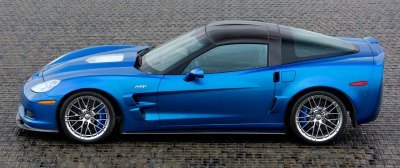
|
Its price is even higher than a
Porsche 911 Turbo in Europe. Ferrari F430 and Lamborghini Gallardo
LP560-4 are also in its sight on the price list. Is GM crazy ?
|
The exterior
look is
also quite disappointing. ZR1 does not depart a lot from the standard
car or Z06, although there are subtle differences such as the extended
lip spoiler, rear spoiler and sills, larger side air vents and more
aggressive wheels. The only significant visual upgrade is a
carbon-fiber bonnet with a pronounced power dome on which a clear Lexan
window is opened. However, if you look through the window, you will see
a toy-like engine cover (think “Transformer”), which is of course not
as desirable as the beautiful Ferrari or Lamborghini engines. In fact,
the see-through window actually cheapens the looks.
Predictably, the new LS9 supercharged V8 takes the center stage. It is
built on the 6162cc LS3 of the regular Corvette – not base on the
7-liter LS7 of Z06 because its thinner wall thickness would not
withstand the higher stress – but upgraded with forged crankshaft,
titanium connecting rods, titanium intake valves and sodium-filled
hollow exhaust valves like the high-revving LS7. In addition, it has
forged aluminum pistons instead of cast ones. The compression ratio and
cam timing are less aggressive than the Z06 engine because of the
presence of supercharger, which sits inside the V-valley and toppled by
a compact air-to-liquid twin-intercooler. The whole package is more
compact than expected.
The roots-type supercharger comes from Eaton – who else makes better
superchargers than it ? Unlike conventional superchargers, its rotors
have 4 lobes instead of 3 to improve supercharging efficiency. Tighter
tolerance also ensures less air leakage. At 0.72 bar full boost, this
supercharger consumes 80 horsepower from the engine, compare with 120
horsepower of conventional 3-lobe superchargers. Overall, the LS9 V8
generates 638 horsepower at 6500 rpm and 604 lb-ft of torque at 3800
rpm, which put the ZR1 among the most powerful cars in the world
regardless of price. Its 6600 rpm redline sounds modest compare with
those 8000-plus rpm Ferraris and Lamborghinis, but with at least 544
lb-ft of torque from 2600 to 6000 rpm, who needs so high rev ?
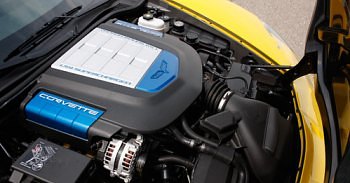
|
...you will see a toy-like engine
cover (think “Transformer”)...
|
Inevitably,
the
supercharged engine puts more weight to the nose. Chevy partly
compensated that with a carbon-fiber bonnet and front fenders. Still,
weight distribution worsens from 50:50 in the Z06 to 52:48. Talking
about weight, the ZR1 did pretty well to limit its kerb weight to 1520
kg, some 90 kg more than Z06 but lighter than most supercars with
similar power. For example, the 620 hp Ferrari 599GTB weighs some 1690
kg, the 640hp Lamborghini Murcielago LP640 weighs 1755 kg and the 670hp
Mercedes SL65 Black weighs 1795 kg. Apart from the aforementioned
bonnet and fenders, carbon-fiber is also used for its roof panel,
rollover bar (B-pillar), lip spoiler and side sills. Besides, it
employs lightweight Brembo carbon-ceramic brakes as standard. The front
brakes employ 6-piston calipers and 394 mm discs; The rear employ 4-pot
calipers and 380 mm discs. Believe or not, they come from Ferrari FXX
and Enzo respectively !
The chassis of ZR1 is fundamentally the same as the Z06. Its suspension
employs softer springs and dampers but thicker anti-roll bars. Magnetic
Selective Ride Control has been added as standard. The steering is
improved by quicker ratio (reduced from 2.78 to 2.54) and a mechanical
variable ratio rack. Tires are upgraded to Michelin PS2 (as in many
European supercars) measuring 285/30ZR19 up front and 335/25ZR20 at the
rear. The gearbox is a strengthened version of the existing Tremec
6-speed manual, whose gear ratios have been revised to give top speed
at 6th.
Having gone through all technical details, now the biggest question in
your mind must be: can ZR1 match or exceed European supercars on the
road ?
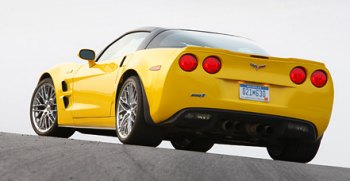
|
A smooth launch is very difficult to
achieve because the rear end is so light...
|
On the Road
The ZR1 looks every bit a traditional American muscle car in
acceleration test. It produces a lot of wheelspin scream and smoke
before gaining traction. A smooth launch is very difficult to achieve
because the rear end is so light (48% of 1520 kg), the engine produces
tremendous torque from low rpm and the lack of any electronic launch
control, unlike its rivals. Even as grippy as the 335/20ZR20 Michelin
Pilot Sport 2, they fail to contain the strong torque in the first 2
gears. This is why American magazines took a lot of attempts before
matching the official claim of 3.4 seconds for 0-60 mph, and this
already excluded the time taken for rolling off the first foot.
Up to 100 mph, the ZR1 is still slower than Ferrari 599GTB. However,
this has more to do with its slower (manual) gearchange compare with
Ferrari’s Superfast F1 gearbox. The shift quality is better than any
Tremec 6-speeders ought to be, but you still won't call it slick. We
can’t help feeling sorry that it
does not offer a more advanced double-clutch or automated manual box
like its rivals, because that would have quicken its gearshift and
enhance the acceleration experience a lot.
That said, the raw power of this super Corvette is never in doubt. Once
overcome the initial wheelspin, it could easily beat Nissan GT-R,
Porsche 911 Turbo and even GT2 in straight line up to any speed. Its
engine noise combines traditional American V8 bass with a high-pitch
supercharger whine. Once the exhaust bypass valves open at 3000 rpm,
the noise gets intense and there comes another shove of power. In
short, it delivers aural thrills accompany with speed.
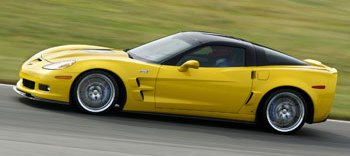
|
The beauty of those Michelin is that
they lose grip progressively at the limit, thus its handling is far
more reassuring than Z06...
|
On racing
track, the
chassis feels much better sorted than the Z06. The magnetic adaptive
damping smoothes out the surface harshness that troubled Z06, making it
a
surprisingly livable car. Its steering delivers higher accuracy, less
kickback and slightly more feel than other Corvettes, although you
won’t confuse it with the helms of Porsche or Ferrari. The Michelin
rubbers are stickier than the Goodyear employed by Z06. However, ZR1
has enough torque to break its traction. This, coupling to the fact
that the car is not as well balanced as Ferrari 599 or Nissan GT-R,
requires more driving skill and self control to keep it tidy in the
twisty. Nevertheless, the beauty of those Michelin is that they lose
grip progressively at the limit, thus its handling is far more
predictable than Z06. It also allows the driver to play throttle steer
pretty easily in fast bends. In addition to the great stopping power of
ceramic brakes, no wonder Jan Magnussen could set a new Nurburgring lap
record at 7:22.4, some 10 seconds faster than Porsche 911 GT2 !
However,
victories in Nurburgring are not necessarily translatable to real
world, especially in the hands of a non-professional driver.
On an unfamiliar mountain road, where the surface is full of
unpredictable irregularities and the corners get
tight, you
need a better balanced and grippier chassis than raw
power. In this way, Nissan GT-R, Porsche 911 or Ferrari 599 GTB will be
better companions than the Vette.
Thanks to its long gearing and
calm suspensions, the ZR1 is a decent cruiser on highway. Nevertheless,
up the pace to Autobahn speed will
reveal its lack of aerodynamic consideration – the car gets unstable
and the wind noise annoyingly loud. Of course, you will aware the
creaks and rattles of its composite body panels and plastic interior
bits. This car lacks the solidity and precision feel of its European
and Japanese counterparts.
Overall, the flagship Corvette still impresses us for its speed and
reasonably well-tamed manner. It is not as versatile as a GT-R or 911
Turbo, but that’s not important, as there are always some car
enthusiasts want something special. In my opinion, the biggest obstacle
to its success is its mass production appeal, poor quality and high
price. I am hard to imagine those who could afford a 911 Turbo or even
a small Lamborghini would prefer this one. GM plans to produce 1800
units a year from now to 2012. It’s not easy to achieve even without
considering the recent economy crisis. |
| The
above report was last updated on 27 Nov
2008. All Rights Reserved. |
|
|